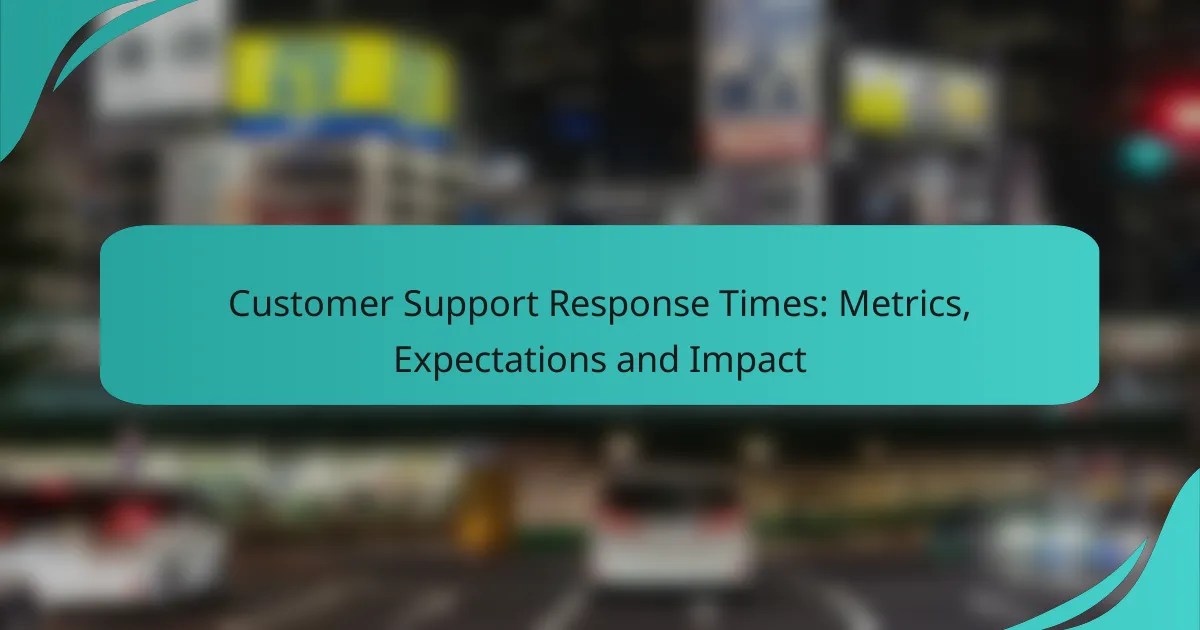In today’s fast-paced environment, customer support response times are critical for maintaining satisfaction and loyalty. In Canada, ideal response times can range from a few minutes to a few hours, depending on the communication channel. By leveraging technology and optimizing staff training, businesses can significantly enhance their response times, leading to improved customer experiences and overall satisfaction.
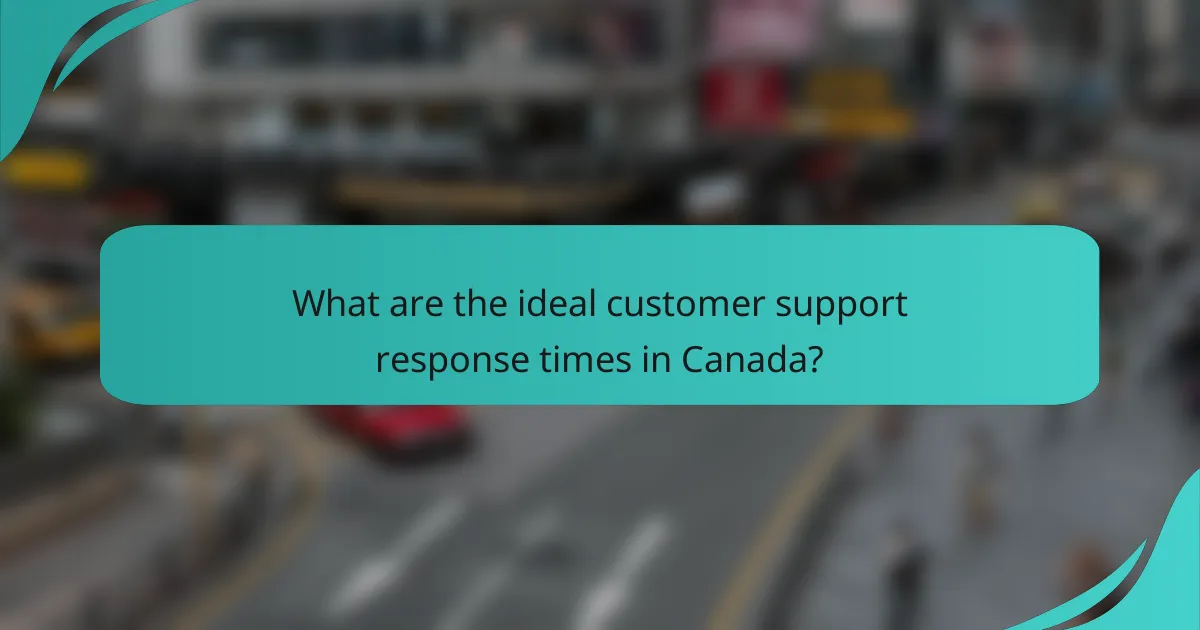
What are the ideal customer support response times in Canada?
The ideal customer support response times in Canada typically range from a few minutes to a few hours, depending on the channel used. Quick responses are crucial for maintaining customer satisfaction and loyalty.
Industry standard response times
Industry standards for customer support response times vary, but many organizations aim for initial responses within 24 hours. For live chat and phone support, the expectation is often much shorter, usually within a few minutes.
In sectors like e-commerce, a response time of under 10 minutes is becoming increasingly common, while email inquiries may take up to 24 hours. Meeting these standards helps businesses maintain a competitive edge.
Response time benchmarks by sector
Different sectors have varying benchmarks for response times. For instance, the technology sector often aims for immediate responses, while the financial services sector may allow for longer response times, typically within 1 to 2 business days.
In retail, quick responses are critical, with benchmarks often set at under 15 minutes for live chat and under 1 hour for email. Understanding these benchmarks can help businesses tailor their customer support strategies effectively.
Customer expectations in Canada
Canadian customers generally expect prompt responses, with many preferring replies within a few hours for email and instant responses for chat or phone inquiries. This expectation is influenced by the growing trend of real-time communication.
Surveys indicate that a significant percentage of customers in Canada expect to receive a response within 30 minutes for urgent issues. Failing to meet these expectations can lead to dissatisfaction and potential loss of business.

How can businesses improve response times?
Businesses can enhance their customer support response times by integrating technology, optimizing staff training, and utilizing effective management tools. These strategies help streamline communication and ensure timely assistance, ultimately improving customer satisfaction.
Implementing chatbots for immediate responses
Chatbots can provide instant responses to customer inquiries, significantly reducing wait times. By handling common questions and issues, they free up human agents to focus on more complex matters.
When deploying chatbots, ensure they are well-programmed to understand various customer intents. Regular updates and training based on customer interactions can improve their effectiveness and accuracy.
Training staff for efficiency
Efficient staff training is crucial for improving response times. Employees should be well-versed in product knowledge and customer service protocols to resolve issues quickly.
Consider conducting regular training sessions and role-playing exercises to enhance communication skills and problem-solving abilities. This can lead to faster resolutions and a more confident support team.
Utilizing customer relationship management (CRM) tools
CRM tools help businesses track customer interactions and streamline support processes. By centralizing customer data, agents can access relevant information quickly, leading to faster response times.
Choose a CRM system that integrates well with existing platforms and offers automation features. This can help prioritize inquiries and assign them to the appropriate staff, improving overall efficiency.

What metrics should be tracked for response times?
To effectively manage customer support, it is essential to track key metrics that reflect response times. The most important metrics include first response time, resolution time, and customer satisfaction score, each providing insights into the efficiency and effectiveness of support interactions.
First response time
First response time measures how quickly a customer receives an initial reply after submitting a support request. This metric is crucial as it sets the tone for the entire customer experience. Aiming for a first response time of under 30 minutes is often considered a best practice in many industries.
To improve first response time, consider implementing automated responses that acknowledge receipt of inquiries. This helps manage customer expectations while your team works on a more detailed reply. Regularly reviewing response times can identify trends and areas for improvement.
Resolution time
Resolution time tracks the duration it takes to fully address and resolve a customer’s issue. This metric is vital for understanding the efficiency of your support processes. A typical resolution time might range from a few hours to several days, depending on the complexity of the issue.
To enhance resolution time, ensure your support team has access to comprehensive resources and training. Utilizing a ticketing system can also streamline the process by prioritizing urgent issues and tracking progress. Regularly analyzing resolution times can help identify bottlenecks in your workflow.
Customer satisfaction score
Customer satisfaction score (CSAT) gauges how satisfied customers are with the support they received. This metric is often collected through post-interaction surveys and is crucial for assessing the overall effectiveness of your customer support. A CSAT score of 80% or higher is generally considered favorable.
To improve CSAT, focus on training your support staff in communication and problem-solving skills. Additionally, actively seeking customer feedback and making adjustments based on their suggestions can lead to higher satisfaction levels. Monitoring CSAT trends over time can provide insights into the impact of changes made within your support processes.
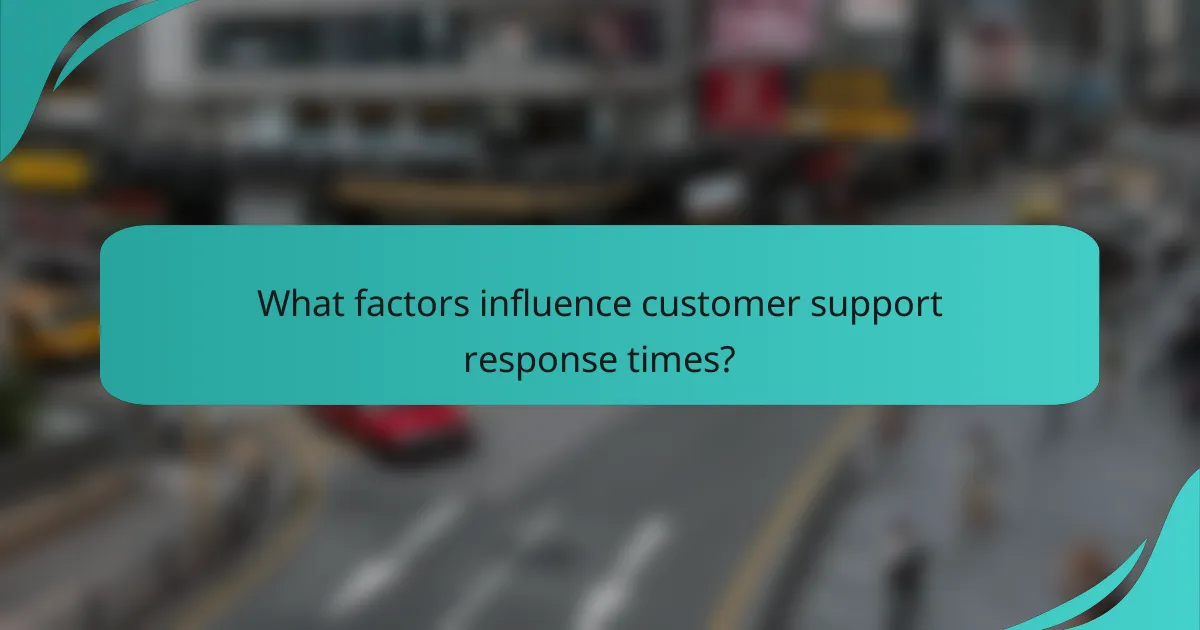
What factors influence customer support response times?
Customer support response times are influenced by several key factors, including the volume of inquiries, the complexity of issues, and the availability and training of staff. Understanding these elements can help businesses set realistic expectations and improve their service efficiency.
Volume of customer inquiries
The volume of customer inquiries directly impacts response times. High volumes can overwhelm support teams, leading to longer wait times for customers. For example, during peak seasons or promotional events, businesses may experience a surge in inquiries that can double or triple normal levels.
To manage high inquiry volumes, companies can implement strategies such as prioritizing urgent requests, using automated responses for common questions, or expanding support hours. These measures can help maintain acceptable response times even during busy periods.
Complexity of issues
The complexity of customer issues also affects how quickly support can respond. Simple questions may be resolved in minutes, while more complex problems could take hours or even days to address. For instance, a billing inquiry may require less time than a technical issue with a product.
To improve response times for complex issues, businesses can categorize inquiries based on difficulty and assign them to specialized teams. This ensures that customers receive accurate assistance without unnecessary delays.
Staff availability and training
Staff availability and training play crucial roles in determining response times. If there are not enough trained agents available, response times will inevitably increase. Companies should assess their staffing needs regularly, especially during peak times, to ensure adequate coverage.
Investing in ongoing training for support staff can also enhance their efficiency. Well-trained agents can resolve issues faster and more effectively, reducing the overall response time. Implementing a knowledge base can further empower agents to find solutions quickly and independently.
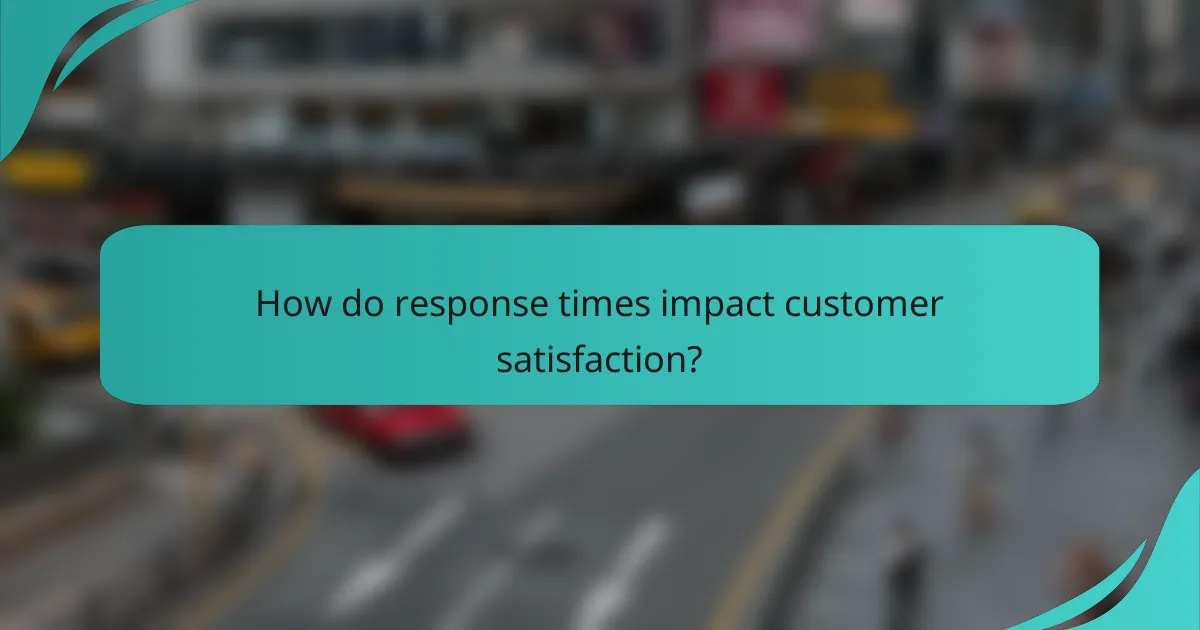
How do response times impact customer satisfaction?
Response times significantly influence customer satisfaction by shaping perceptions of service quality. Quick responses typically lead to higher satisfaction levels, while delays can frustrate customers and diminish their overall experience.
Correlation between response time and satisfaction
Research consistently shows a strong correlation between response times and customer satisfaction ratings. Customers expect timely replies, often within minutes for chat support and a few hours for email inquiries. Meeting these expectations can enhance their overall impression of a brand.
For example, companies that respond within the first hour of a customer inquiry often see satisfaction rates increase by a notable margin. Conversely, delays beyond a few hours can lead to dissatisfaction and negative perceptions.
Long-term customer loyalty effects
Consistent response times can have lasting effects on customer loyalty. When customers experience prompt service, they are more likely to return and recommend the brand to others. This loyalty can translate into repeat business and positive word-of-mouth, which are invaluable for growth.
On the other hand, poor response times can lead to churn, where customers seek alternatives. Brands should aim for a balance, ensuring that response times are not only quick but also maintain quality interactions to foster long-term relationships.

What are the regional differences in response time expectations?
Response time expectations vary significantly across regions, influenced by local culture, industry standards, and customer preferences. Understanding these differences is crucial for businesses aiming to meet or exceed customer expectations in various locations.
Variations across Canadian provinces
In Canada, response time expectations can differ markedly from province to province. For example, customers in British Columbia may expect quicker responses due to a tech-savvy population, while those in Newfoundland might be more tolerant of longer wait times. Generally, urban areas in provinces like Ontario and Quebec demand faster service, often within a few hours, compared to more rural regions.
Businesses should consider these regional nuances when setting their customer support standards. Tailoring response times to local expectations can enhance customer satisfaction and loyalty.
Urban vs. rural response time expectations
Urban customers typically expect faster response times compared to their rural counterparts. In cities, where competition is fierce, customers may anticipate replies within minutes, especially for online support. In contrast, rural areas often see acceptable response times extending to several hours or even a day.
To effectively manage expectations, businesses should analyze their customer demographics and adjust their service levels accordingly. Offering tiered support options can help meet the varying demands of urban and rural customers, ensuring that all feel valued and supported.
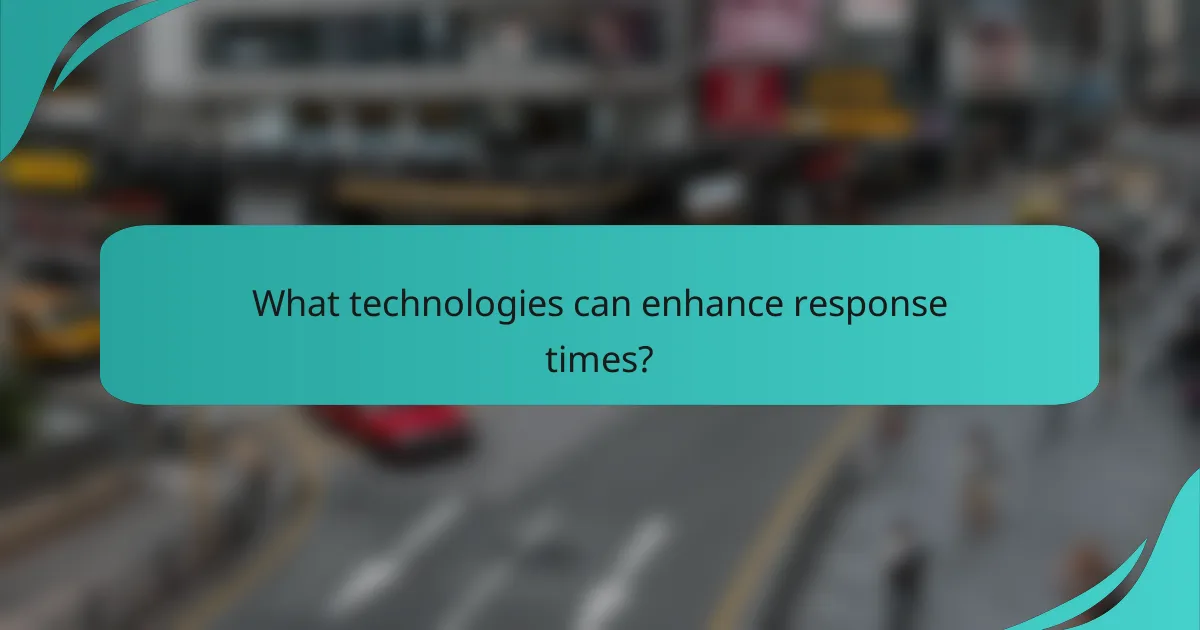
What technologies can enhance response times?
Technologies that enhance customer support response times include chatbots, automated ticketing systems, and customer relationship management (CRM) software. These tools streamline communication, reduce wait times, and improve overall efficiency in handling customer inquiries.
Chatbots
Chatbots can significantly reduce response times by providing instant answers to frequently asked questions. They operate 24/7 and can handle multiple inquiries simultaneously, allowing human agents to focus on more complex issues. Implementing chatbots can lead to quicker resolutions and higher customer satisfaction.
Automated Ticketing Systems
Automated ticketing systems help manage customer inquiries by categorizing and prioritizing requests based on urgency. This technology ensures that high-priority issues are addressed promptly, minimizing delays. By automating the ticketing process, organizations can improve their response times and maintain better service levels.
Customer Relationship Management (CRM) Software
CRM software centralizes customer information, enabling support teams to access relevant data quickly. This access allows agents to respond more efficiently to inquiries and tailor their responses based on customer history. A well-implemented CRM system can lead to faster resolution times and improved customer experiences.






